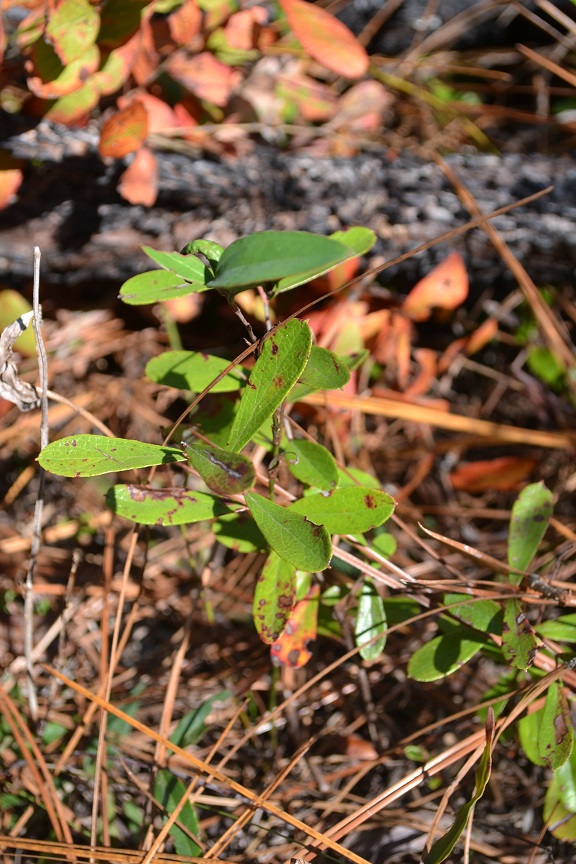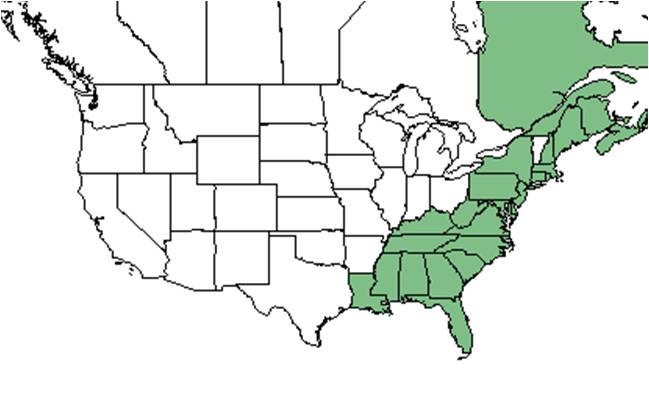Gaylussacia dumosa
| Gaylussacia dumosa | |
|---|---|

| |
| Photo taken by Kevin Robertson | |
| Scientific classification | |
| Kingdom: | Plantae |
| Division: | Magnoliophyta - Flowering plants |
| Class: | Magnoliopsida - Dicotyledons |
| Order: | Ericales |
| Family: | Ericaceae |
| Genus: | Gaylussacia |
| Species: | G. dumosa |
| Binomial name | |
| Gaylussacia dumosa (Andrews) Torr. & A. Gray | |

| |
| Natural range of Gaylussacia dumosa from USDA NRCS Plants Database. | |
Common names: Dwarf huckleberry; Southern dwarf huckleberry
Contents
Taxonomic notes
Synonyms: Gaylussacia dumosa (Andrews) Torrey var. dumosa; Lasiococcus dumosus (Andrews) Small
Description
A description of Gaylussacia dumosa is provided in The Flora of North America.
Distribution
Its main distribution is throughout the southeastern coastal plain, from New Jersey to Florida and west to eastern Louisiana, and less common more inland.[1] It is also native to the Canadian provinces of Quebec, New Brunswick, Nova Scotia, and Newfoundland & Labrador; it is also found in St. Pierre Miquelon located near Newfoundland & Labrador province.[2]
Ecology
Habitat
Gaylussacia dumosa is commonly found in mesic to xeric, acidic woodlands and forests.[1] It is restricted to native groundcover with a statistical affinity in upland pinelands of South Georgia. [3] G. dumosa responds negatively to soil disturbance in longleaf pine communities in South Carolina.[4]
Phenology
G. dumosa has been observed to flower March to May and in October with peak inflorescence in April.[5]
Seed dispersal
This species is thought to be dispersed by consumption by vertebrates. [6] In particular, it has found to be dispersed by gopher tortoise (Gopherus polyphemus).[7]
Pollination
The following Hymenoptera families and species were observed visiting flowers of Gaylussacia dumosa at Archbold Biological Station: [8]
Apidae: Apis mellifera, Bombus impatiens
Halictidae: Augochlorella aurata, A. gratiosa
Megachilidae: Megachile brevis pseudobrevis, M. integrella
Conservation and management
Cultivation and restoration
Photo Gallery
References and notes
- ↑ 1.0 1.1 Weakley, A. S. (2015). Flora of the Southern and Mid-Atlantic States. Chapel Hill, NC, University of North Carolina Herbarium.
- ↑ USDA, NRCS. (2016). The PLANTS Database (http://plants.usda.gov, 15 May 2019). National Plant Data Team, Greensboro, NC 27401-4901 USA.
- ↑ Ostertag, T.E., and K.M. Robertson. 2007. A comparison of native versus old-field vegetation in upland pinelands managed with frequent fire, South Georgia, USA. Pages 109–120 in R.E. Masters and K.E.M. Galley (eds.). Proceedings of the 23rd Tall Timbers Fire Ecology Conference: Fire in Grassland and Shrubland Ecosystems.
- ↑ Brudvig, L.A. and E.I. Damchen. (2011). Land-use history, historical connectivity, and land management interact to determine longleaf pine woodland understory richness and composition. Ecography 34: 257-266.
- ↑ Nelson, G. PanFlora: Plant data for the eastern United States with emphasis on the Southeastern Coastal Plains, Florida, and the Florida Panhandle. www.gilnelson.com/PanFlora/ Accessed: 9 DEC 2016
- ↑ Kay Kirkman, Jones Ecological Research Center, unpublished data, 2015.
- ↑ Carlson, J. E., E. S. Menges, and P. L. Marks. 2003. Seed dispersal by Gopherus polyphemus at Archbold Biological Station, Florida. Florida Scientist, v. 66, no. 2, p. 147-154.
- ↑ Deyrup, M.A. and N.D. 2015. Database of observations of Hymenoptera visitations to flowers of plants on Archbold Biological Station, Florida, USA.
